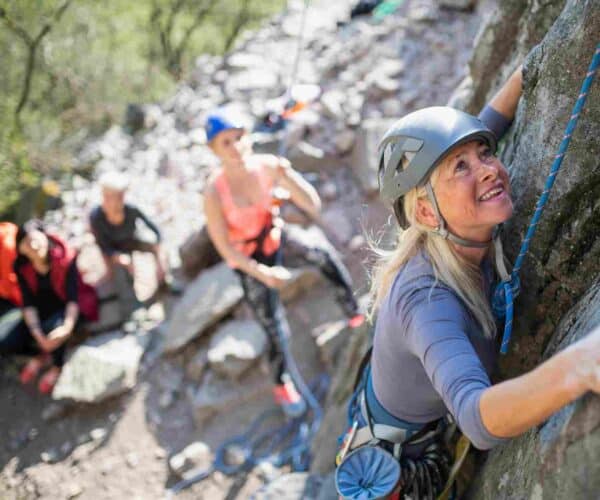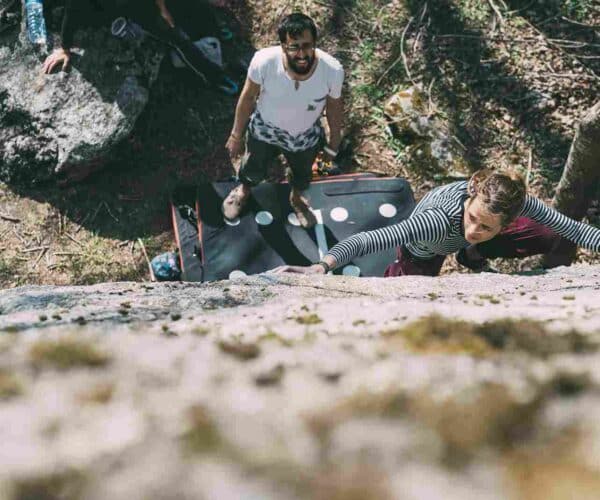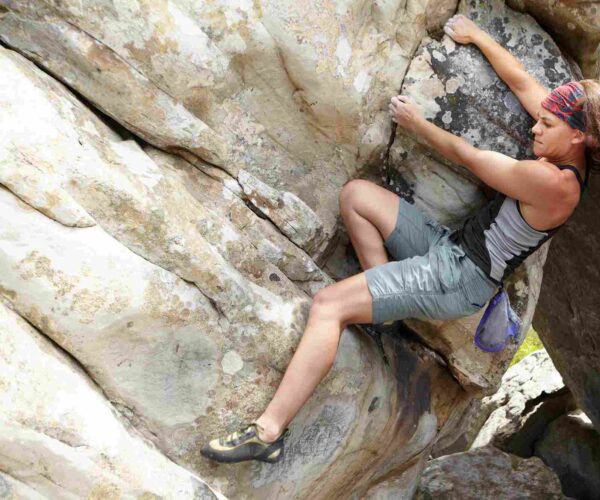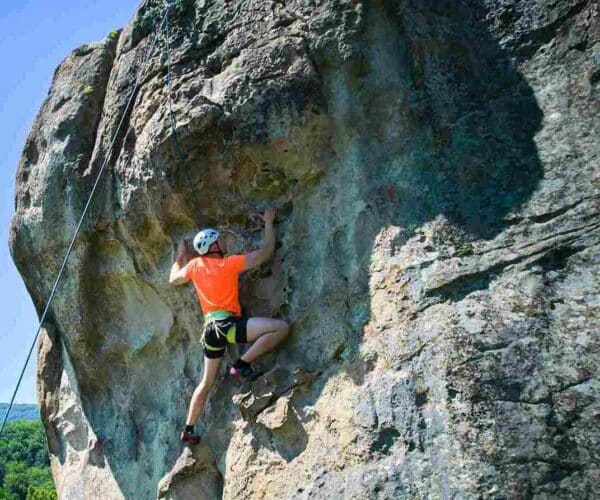Rock climbing in the UK is a hugely popular sport, with thousands of indoor and outdoor locations catering to enthusiasts of all skill levels. Within the climbing world, two of the most common disciplines are bouldering and roped climbing. While both involve ascending rock faces, they have significant differences in technique, equipment, terrain, and difficulty. Understanding these distinctions can help UK climbers decide which style suits them best. In this guide we’ll explore the main differences between climbing and bouldering.
What is climbing?

Climbing, often referred to as sport or trad climbing, involves ascending a rock face or indoor wall using a harness and rope for safety. Climbers secure themselves to pre-placed bolts (sport climbing) or use removable protection gear (trad climbing) to prevent falls. Routes can range from short single-pitch climbs to long multi-pitch routes in the mountains.
What is bouldering?

Bouldering, by contrast, is a form of climbing that involves tackling shorter routes, known as ‘problems’, without the use of ropes or harnesses. Climbers rely on crash pads to cushion their falls and often work with spotters to help direct their landings. Bouldering tends to focus on strength and technical movement over endurance.
Differences in equipment
Climbing equipment
• Ropes and harnesses – Essential for sport and trad climbing, providing safety at height.
• Climbing protection – Includes quickdraws for sport climbing and cams, nuts, and slings for trad climbing.
• Belay devices – Used to control the rope and catch a falling climber.
• Climbing shoes – Tight-fitting shoes designed for optimal grip and precision on rock surfaces.
• Helmet – Crucial for protecting against falling debris or unexpected impacts.
Bouldering equipment
• Climbing shoes – Often more downturned and aggressive for precision on small holds.
• Chalk – Used to keep hands dry and improve grip.
• Crash pads – Thick foam mats placed below problems to absorb falls.
Climbing and Bouldering techniques

Body positioning:
• Climbing: Focuses on efficient, balanced positions over longer distances.
• Bouldering: Requires dynamic, high body tension for short, powerful moves.
Footwork:
• Climbing: Emphasises precise, energy-conserving footwork.
• Bouldering: Footwork is important but less technical, focusing on quick, strong
Grip and handholds:
• Climbing: Involves various grips for longer holds and techniques.
• Bouldering: More explosive, using power for short, intense grips.
Strength vs. technique
• Climbing: Technique and endurance are key over longer climbs.
• Bouldering: Strength and explosive power dominate short, intense problems.
Resting techniques:
• Climbing: Frequent rests are used to reduce fatigue.
• Bouldering: Minimal resting, with short bursts of energy.
Difference in terrain
When it comes to bouldering and climbing, the terrain plays a significant role in how each is approached. Bouldering typically takes place on shorter rock formations, usually around 15–20 feet. The focus is on tackling specific, powerful problems using features like overhangs, crimps, and slopers. Since the climbs are relatively short, safety is centred around falls, with crash pads used to cushion impacts. On the other hand, climbing generally involves taller routes, which can range from 30 feet indoors to hundreds of feet outdoors. These routes offer a wider variety of features, cracks, slabs, vertical faces, and overhangs, requiring a mix of endurance and technique. Climbers use ropes, harnesses, and protective gear to ensure safety while tackling longer, more complex routes. Ultimately, bouldering is all about quick, intense challenges on smaller rock faces, while climbing requires more equipment and stamina to conquer taller, diverse terrains.
Climbing locations in the UK
Outdoor climbing in the UK offers incredible diversity, from the limestone cliffs of the Peak District to the rugged granite of Dartmoor and the dramatic sea cliffs in Pembrokeshire. Indoor climbing gyms, such as The Castle in London and The Climbing Works in Sheffield, provide year-round training facilities for climbers of all abilities.
Bouldering locations in the UK
Bouldering tends to take place on lower rock formations and indoor climbing gyms. Popular UK outdoor bouldering locations include Stanage Edge in the Peak District, The Roaches in Staffordshire, and the famous gritstone boulders of Yorkshire. Many indoor centres, such as The Depot and The Arch Climbing Wall, cater exclusively to bouldering enthusiasts.
Best climbing and bouldering locations worldwide

For those looking to expand their climbing horizons beyond the UK, some of the best spots worldwide include:
Best climbing locations
• Yosemite National Park, USA – Home to iconic big wall climbs like El Capitan and Half Dome.
• Fontainebleau, France – A world-renowned sandstone climbing area with thousands of routes.
• Kalymnos, Greece – A paradise for sport climbers, offering stunning limestone cliffs and sea views.
• Red River Gorge, USA – Famous for its overhanging sandstone sport routes.
• El Chaltén, Argentina – A dream destination for alpine climbers with the Fitz Roy range.
Best bouldering locations
• Rocklands, South Africa – One of the world’s best bouldering areas, known for its high-quality sandstone.
• Hueco Tanks, USA – A desert bouldering haven offering unique rock formations.
• Magic Wood, Switzerland – A forested bouldering destination with granite boulders and scenic views.
• Squamish, Canada – Famous for both traditional climbing and top-tier granite bouldering problems.
• Grampians, Australia – A mix of challenging boulder problems set in a stunning natural environment.
Which is harder to learn?
Climbing, particularly trad climbing, has a steep learning curve due to the technical aspects of rope work, belaying, and gear placement. However, sport climbing on indoor walls or bolted routes is more accessible for beginners, as it requires less technical knowledge and allows climbers to focus on movement rather than safety systems.
Bouldering is often seen as the easier entry point into climbing because it doesn’t require ropes or belay partners. However, it can be physically demanding, as problems typically involve short, powerful movements that require strength and technique. Fear of falling is also more immediate in bouldering, as there is no rope to catch you, though crash pads help mitigate the risk.
Safety considerations
Climbing safety
• Rope systems and belay devices prevent long falls by absorbing impact and providing controlled descents.
• Regular equipment checks are essential for safety, ensuring harnesses, ropes, carabiners, and belay devices are in good condition.
• Outdoor climbing requires knowledge of anchor building and protection placement to ensure secure attachment points and avoid accidents.
• Understanding route difficulty and conditions helps climbers make informed decisions and avoid unnecessary risks.
• Partner communication is key, as clear commands between climber and belayer prevent miscommunication and ensure smooth climbs.
Bouldering safety
• Falling is part of the sport, so proper technique is crucial. Learning how to fall safely, such as rolling on impact and avoiding landing on outstretched hands which reduces injury risk.
• Spotters help guide falls to avoid injuries. A good spotter will position themselves correctly to direct the climber’s fall onto a safe landing area rather than trying to catch them outright.
• Good crash pad placement is essential to cushion impacts. Ensuring pads are well-positioned, with no gaps between them, provides better protection from awkward landings.
• Awareness of surroundings is vital. Outdoor boulderers should watch for uneven ground, sharp rocks, or other hazards that could cause injury upon landing.
• Warming up and stretching before a session helps prevent muscle strains and injuries, especially given the dynamic movements required in bouldering.
When partaking in a sport like climbing and bouldering that can be dangerous, it’s important to ensure you have specialist climbing or bouldering insurance in place to add to your safety if something goes wrong. In the event of a nasty fall or accident, having the right policy in place can not only provide you with the medical assistance you may need, but also financially protect you.
Physical and mental benefits
Climbing and bouldering both offer significant physical and mental benefits. Climbing enhances overall endurance, as routes tend to be longer and require sustained effort, while bouldering focuses on developing explosive power due to its short, intense movements. Both disciplines improve problem-solving skills, as climbers must strategise and adapt their approach to tackle routes efficiently. Additionally, they foster mental resilience by helping individuals overcome fear, build confidence, and push their physical and psychological limits. Whether managing exposure on a high wall or committing to a difficult move on a boulder problem, climbers develop perseverance and adaptability.
Cost comparison: climbing vs bouldering
• Equipment costs – Climbing gear is generally more expensive due to ropes and protection.
• Gym memberships – Indoor climbing tends to cost more than bouldering gyms.
• Outdoor expenses – Travel and accommodation can add up for both disciplines.
Social aspects: community and culture
• Bouldering fosters a more social, collaborative atmosphere.
• Climbing often involves partnerships and trust-building with belay partners.
• Competition scenes differ, with bouldering comps being faster-paced.
Which one is right for you?
If you enjoy problem solving and high intensity moves, bouldering may be the better choice. If you prefer endurance challenges, rope systems, and multi-pitch adventures, traditional or sport climbing might suit you better. Luckily, the UK offers incredible opportunities for both, whether indoors or on stunning outdoor crags. Whichever discipline you choose, the key is to enjoy the climb!
Climbing Insurance from SportsCover Direct
Whether you choose bouldering or roped climbing, having climbing insurance is essential for covering potential injuries or accidents, especially when climbing outdoors.
SportsCover Direct’s specialist travel insurance provides cover for climbing and bouldering while abroad. If you’re participating abroad but already have travel insurance, why not take a look at our bolt-on policy. This provides you cover for your climbing, when your general travel insurance policy might not.
Alternatively, if you’re taking part in the UK, take a look at our sports accident policy!
To find out more about our tailored policies, head to our website and get a quick quote today.
This blog has been created as general information and should not be taken as advice. Make sure you have the correct level of insurance for your requirements and always review policy documentation.